Map
Hermitage of Calomini
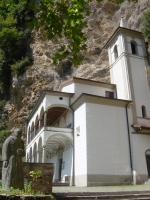
LOCATION:
The Hermitage of Calomini is located along the road to the village of Vergemoli, above the village of Gallicano.
ARCHITECTURE:
The church of the hermitage was built almost at the front of the mountain, even more than half, with the vestry and most of the convent, it proceeds in an excavation inside the mountain, with the use of a single chisel.
The top of this excavation, ending in a very wide turn whitish.
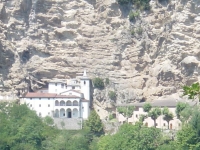
From the main church, decorated in eighteenth-century style, it enters the sacristy, the original place of worship, which was in the seventeenth century, furnished with splendid carved furniture.
From here the tour continues in the old kitchen and in the cells of monks, also carved into the rock as the vestry.
Around the foundation of this shrine looming in many legends, mostly related to the image of the Virgin venerated there.
The area is rich in tourist attractions such as the Wind Cave which is located inside the park of the Apuan Alps.
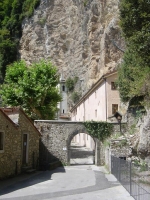
According to tradition, the place still rocks stems from a gush of water pure, the image of the Virgin Mary which is venerated at the shrine turned out to be a shepherdess of Calomini.
The girl's name is unknown, it is known whether Madonna spoke to the girl.
Now the fame of the saint are scattered in the nearby villages and admirably grew between those people a desire to honor them.
Thus, many devotees accompanied the image of the madonna in Gallicano, a place deemed more honorable.
But, although closely guarded, not passed twenty-four hours was again found that he had made to see the shepherdess of Calomini. Know the will of Mary with this miracle, no more ard�a remove from his cave.
It is thought then to build on a worthy dwelling place and was raised so much money that at first it gave the image a sacred altar, then the whole church was excavated in the mountain S. Maria ad Martyres.
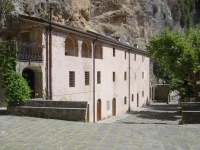
In reality it seems more likely that the hermitage is built in an attempt to recreate an environment similar to that the ascetics of the Thebaid.
And it seems that the objective has been achieved in full.
Architecture human nature and architecture are interwoven with each other, and the rock is placed the stuccoes, with arches and columns.
VARIATIONS:
Some shepherds found near the mountain a statue of Madonna and put it inside a cave.
As a result of this fact has made many miracles. The place became a place of pilgrimage, and built the first sanctuary, which was excavated from the rock and when it was given the name of S. Maria ad Martyres.
The second tells of a woman who fell from Calomini steep wall of the mountain, but when he touched ground he realized that it integrates completely, because, while falling, had invoked the Virgin Mary. So in this place was built the shrine.
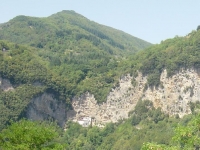
The primitive Church of the eleventh century it was enlarged in sec. XIV and XVIII.
By the document of 1361, where the "converso" ("converso" monk: is a cleric who belongs to an order and as the religious habit) of the cell of St. Maria ad Martyres applied to the Bishop of legalizing the various offerings of the oratorio, appears clear what was the veneration of the Virgin surrounded the cave (or of the pen) from the fourteenth century.
The first act of the Bishop of free placement of the benefit on the hermitage of Saint Mary of the cave is May 2 1444.
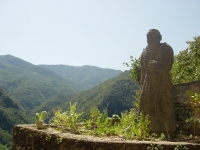
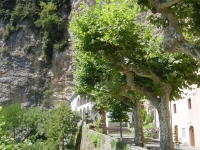
By decree of the bishop of Massa dating back to 1941, the sanctuary was entrusted to the custody of the PP Capuchins of Lucca, which, in the person of a brother, have done so for over fifty years to keep this a pure devotion to Mary, wanted to arise on this cliff. This monastery was once inhabited by monks of the Capuchin order, is now occupied by the Disciples of the Annunciation. Details on Il Tirreno
In May and in September still many believers ascend the this cliff, which conserves intact the miracle water and separates the dark, in a vision of absolute purity, towards the lonely frontiers of fear. The excursions are suitable for everyone and can be performed on the same day of the visit to the Grotta del Vento.
HOW TO GET IT:
From Gallicano take the road that leads to Fornovolasco and the Grotta del Vento.
After the junction, on the left, for Verni and Trassilico (Km 2.4), we arrive after 450 meters and started on the right, the narrow road, traveled only by car, which in less than one chilometre leading to the square of the Hermitage (4.1 Km from Gallicano).
The Hermitage is located along the river Turrite. If you travel by bus, you must park on the square located at the beginning of the street, and walk through a path pointed forward in twenty minutes.
The Hermitage of Calomini is an impressive architectural complex located at the base of a large overhanging wall about 70 meters high, is recessed to within 15 meters of rock.
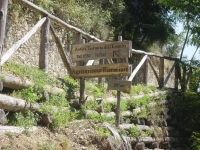
ACCOMMODATIONS and RESTAURANT:
- Antica trattoria dell'Eremita di Calomini